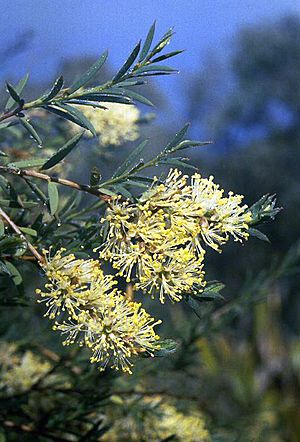Pungent honey-myrtle facts for kids
Quick facts for kids Pungent honey-myrtle |
|
|---|---|
 |
|
| Scientific classification | |
| Genus: |
Melaleuca
|
| Species: |
leiocarpa
|
The Melaleuca leiocarpa, commonly known as the Pungent Honey-Myrtle, is a plant from the myrtle family. It grows naturally in dry areas of South Australia and Western Australia. This plant is a shrub that can grow upright or have many branches. It stands out because of its prickly leaves, yellowish flowers, and unusually large, smooth, round fruits.
Contents
What the Pungent Honey-Myrtle Looks Like
The Pungent Honey-Myrtle can grow up to 5 m (20 ft) tall. It has rough, dark grey bark with deep lines. Its leaves are arranged in a spiral pattern around the stem. They are about 6–21.8 mm (0.2–0.9 in) long and 1.5–5 mm (0.06–0.2 in) wide. The leaves are narrow and pointy, like a spear, with a very short stem.
The flowers grow in groups of 3 to 14 at the ends of the branches. These flower clusters can be up to 15 mm (0.6 in) long and 28 mm (1 in) wide. The stamens, which are the parts of the flower that make pollen, are bright yellow. They are grouped into five bundles, with 11 to 22 stamens in each bundle.
Flowers usually appear between August and December. After the flowers, the plant produces fruits. These fruits are woody, round capsules, about 7–9 mm (0.3–0.4 in) across.
How It Got Its Name
Melaleuca leiocarpa was first officially described in 1876. This was done by Ferdinand von Mueller, a famous botanist, in his book "Fragmenta phytographiae Australiae".
The second part of its scientific name, leiocarpa, comes from two ancient Greek words. Leîos means "smooth," and karpós means "fruit." This name describes the plant's smooth fruits.
Where It Grows
The Pungent Honey-Myrtle is found in the Gawler Ranges and northern Eyre Peninsula in South Australia. It also grows in dry parts of eastern Western Australia.
You can find it in areas like the Avon Wheatbelt, Central Ranges, Coolgardie, Gascoyne, Geraldton Sandplains, Great Victoria Desert, Murchison, Pilbara and Yalgoo. It prefers rocky soils and red sand on hillsides, rocky areas, and sandplains.
Conservation Status
The Government of Western Australia Department of Parks and Wildlife says that Melaleuca leiocarpa is "not threatened." This means it is not currently in danger of disappearing.
Uses of the Plant
Growing in Gardens
This type of melaleuca is not often grown in gardens. However, it is a very beautiful shrub when it is covered in flowers. It can grow well in most types of soil. It is a tough plant if the soil drains well and it gets plenty of sunshine.
Essential Oils
The leaves of the Pungent Honey-Myrtle contain special oils. These oils are mostly made up of compounds called monoterpenoids.

